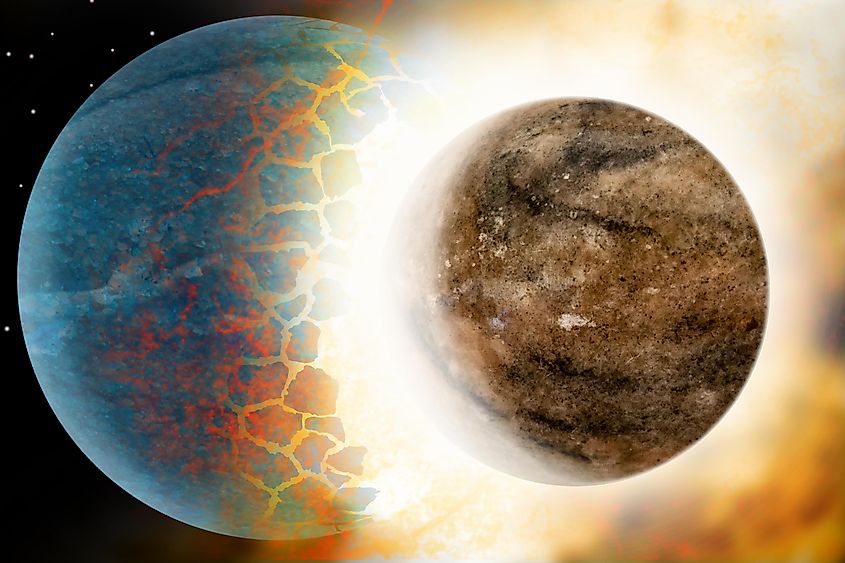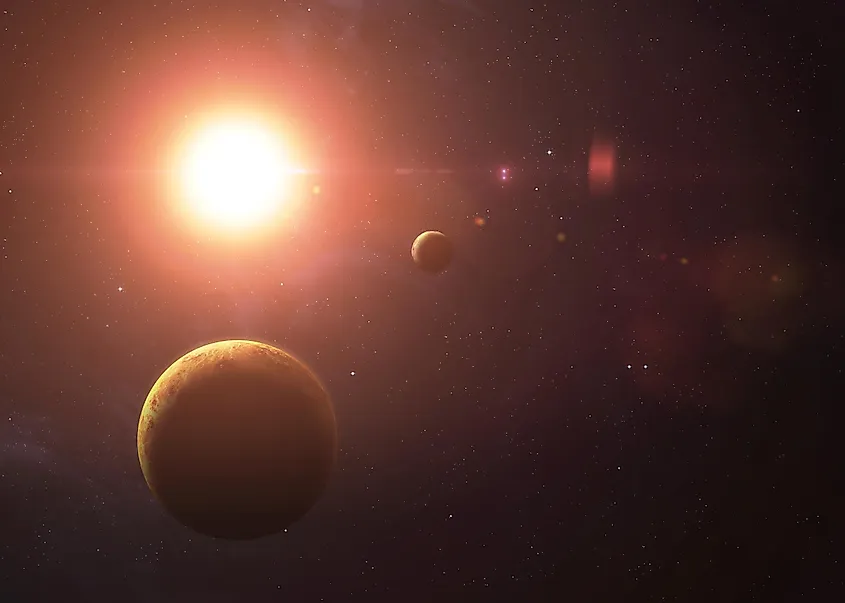An interesting fact about the solar system is that all the planets, with one exception, rotate counterclockwise. The reason behind their consistent behavior is fairly simple. The direction the planets rotate is the same direction the sun rotates, and the sun rotates counterclockwise because the material from which it formed happened to do so as well. To clear things up, after the sun was formed from a cloud of dust and gas inside the protoplanetary disk surrounding it, which rotated counterclockwise, the planets that are now present in our solar system eventually formed. This resulted in a consistent pattern of spinning among all planets except Venus. Earth's nearest planetary neighbor, Venus, rotates clockwise. Why does Venus rotate the "wrong" way?
Planetary Collision

After it formed, Venus likely rotated counterclockwise like all the other planets. It simply would not have been possible for Venus to rotate clockwise after its formation, given the rotation of the protoplanetary disk it formed in. Instead, something must have caused Venus to start spinning the other way. Shortly after the sun was born, the planets began to form as well. Although the solar system has eight planets today, that has not always been the case. There were likely as many as a hundred planets forming in the early solar system. The early solar system was chaotic, and none of the current planets had found themselves in a stable orbit. The gravitational pull of the forming planets tugged on one another and brought each other closer together. Collisions between entire planets were commonplace, and every planet in the solar system is believed to have undergone one or more crashes in the past. Venus was no exception, and it likely experienced at least one major collision with another planet. A collision between Venus and another planet could explain why Venus rotates counterclockwise. Another planet colliding with Venus at just the right angle could have reversed its rotation.
Furthermore, this hypothesis explains why Venus rotates so slowly. It takes Venus 243 Earth days to complete one rotation about its axis. That is exceptionally long compared to Earth's 24-hour rotation. Since Venus likely had a reasonably fast counterclockwise rotation at one point, a collision with another world would not have had sufficient enough energy to cause Venus to rotate quickly in the other direction. In conclusion, the collision would have both reversed and slowed down the rotation of Venus.
Other Explanations

A planetary collision is not the only viable hypothesis that explains the counterclockwise rotation of Venus. It's possible that Venus was actually flipped upside down rather than rotating the wrong way. This would mean that Venus does turn the correct way; it's just that the entire planet was flipped over. How exactly do you flip a planet? One explanation has to do with the atmosphere of Venus. The Venusian atmosphere is very dense, having an atmospheric pressure 90 times greater than Earth's. The sun's gravitational pull could have pulled on Venus' atmosphere, causing tidal friction. Combine this atmospheric tidal friction with friction between the mantle and core of Venus, and the entire planet would flip upside down. As of yet, it remains unknown exactly how Venus ended up rotating clockwise.
https://www.worldatlas.com/space/the-only-planet-that-rotates-clockwise.html
2022-04-25 07:41:43Z
CBMiTGh0dHBzOi8vd3d3LndvcmxkYXRsYXMuY29tL3NwYWNlL3RoZS1vbmx5LXBsYW5ldC10aGF0LXJvdGF0ZXMtY2xvY2t3aXNlLmh0bWzSAVBodHRwczovL3d3dy53b3JsZGF0bGFzLmNvbS9hbXAvc3BhY2UvdGhlLW9ubHktcGxhbmV0LXRoYXQtcm90YXRlcy1jbG9ja3dpc2UuaHRtbA
Bagikan Berita Ini















0 Response to "The Only Planet That Rotates Clockwise - Worldatlas.com"
Post a Comment